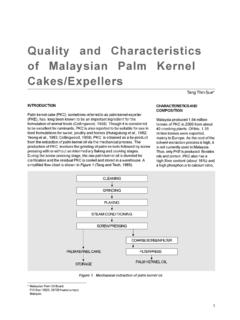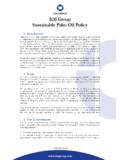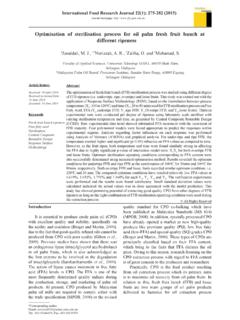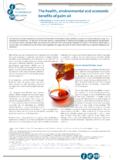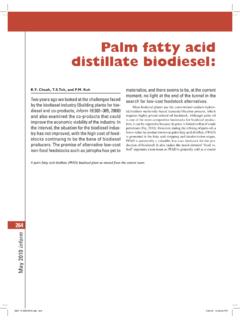Transcription of Palm Oil Developments 62 New Developments in Palm Oil ...
1 Palm Oil Developments 624 Saw Mei Huey*, Chong Chiew Let* and yeoh Chee Beng** malaysian Palm Oil Board (MPOB) 6, Persiaran Institusi, Bandar Baru Bangi, 43000 Kajang, Selangor, Malaysia. E-mail: Developments in Palm Oil FractionationINTRODUCTIONF ractionation, a precursor of the modern edible oil and fat processing industry, is the oldest separation process. It plays an important role, especially in the palm oil industry, owing to the composition of palm oil which contains about equal amounts of saturated and unsaturated fatty acids. The physical nature of palm oil, exhibiting a semi-solid state in the malaysian tropical climate, allows its separation into a low-melting fraction, olein, and a high-melting fraction, stearin (Deffense, 1985). Fractionation can be defined as the separation of a mixture into its component fractions. Generally, the concept of a physical separation process can be based on a few parameters such as differences in solidification, solubility and volatility of the different compounds.
2 The common techniques used for fractionation are fractional crystallisation, fractional distillation, short-path distillation, supercritical fluid extraction, liquid-liquid extraction, adsorption, complexion and membrane separation. (Kellens et al., 2007). In the oils and fats industries, fractional crystallisation is the process used for separating oils and fats into two or more components, and it involves two steps: selective crystallisation and filtration. There are three fractionation processes used to fractionate palm oil, namely, dry fractionation, detergent fractionation and solvent FractionationDry fractionation is the sim-plest and cheapest process, which is most commonly used in palm oil refineries. As the name suggests, it is a dry process using direct filtra-tion of triacylglycerol crystals after controlled programmed cooling. This process is simple because it does not depend on any chemi-cal and no effluent is produced during the process.
3 Hence, this process has an advantage of mini-mum product losses (Kellens et al., 2007). In dry fractionation, the oil is partially crystallised by controlled cooling of the molten feed to the desired fractionation temperature, holding the partially crystallised slurry for crystal growth, followed by filtration using a membrane fil-ter press (Gunstone, 2001). Figure 1 shows various palm oil products obtained from single-, double- and triple-stage dry fractionation pro-cesses. Single-stage dry fractiona-tion of palm oil can be used to produce palm oleins with IV of 56 and 62. The saturation content of palm olein can be further reduced by using multiple stage fractiona-tion in which double- and triple-stage fractionation can be used to produce oleins with IV of 65 (super olein) and IV 70 (top olein), respec-tively (Gijs et al., 2007; Kellens et al., 2007).Detergent FractionationDetergent fractionation, first developed by Lanza, involves the addition of a detergent as a wet-ting agent to improve the separa-tion of the crystals from the liquid phase (Deffense, 1985).
4 Sodium lauryl sulfate is usually used as the wetting agent, in combination with magnesium sulfate as the electro-lyte (Kellens and Hendrix, 2000). 5 New Developments in Palm Oil FractionationFigure 1. Dry fractionation of palm oil and its products from single-, double- and triple-stage dry the partially crystallised slur-ry is mixed with the detergent solu-tion, the crystals are wetted by the detergent and are easily suspended in the aqueous phase; the mixture is then separated by centrifugation (Kellens et al., 2007). The aque-ous phase is then heated and the melted stearin is recovered through a second centrifugation step. The olein and stearin fractions are washed with water and dried to re-move the trace amounts of deter-gent (Deffense, 1985). Detergent fractionation has lost its appeal due to detergent contamination of the end products and the high produc-tion cost (Kellens et al., 2007). Solvent FractionationSolvent fractionation is the most efficient fractionation pro-cess compared with the other frac-tionation processes (Kellens and Hendrix, 2000).
5 It was initially de-veloped to overcome some bulk crystallisation problems, such as slow heat transfer and high viscos-ity which limit nuclei movement. In solvent fractionation, the oil is diluted in organic solvents such as acetone and hexane in certain proportions to reduce its viscosity, which is higher when using dry and detergent fractionations (Kellens et al., 2007). In dry fractionation, it is not possible to remove all the liq-uid from the solid phase, as some liquid will remain entrapped in the solid fraction. Solvent fractionation is more efficient in reducing liquid oil entrapment, thus enhancing the liquid oil yield as well as increasing the hardness of the solid fraction. Similar to detergent fractionation, solvent fractionation has also lost its lure due to its high production cost and higher risk of fire and to human health (Kellens et al., 2007).CURRENT Developments IN PALM OIL FRACTIONATIONR ecent Developments in palm oil fractionation are mainly focused on areas related to crystallisation and solid-liquid separation.
6 The quality of the olein fraction depends only on the crystallisation step, whereas the quality of stearin fraction de-pends on both the crystallisation and separation steps (Timms, 2005). A few stages are required for the fractionation of fats. They are su-percooling of the melt, nucleation and crystal growth (Kellens et al., 2007). At temperatures much low-er than the supercooling tempera-ture, nuclei can be formed in the system (Lawler and Dimick, 2002). Nuclei are defined as the smallest crystals that can exist in a solution at a particular concentration and temperature (Timms, 2005). There are three types of nucleation phe-nomena, primary nucleation including homogeneous nuclea-tion, heterogeneous nucleation, and secondary nucleation (Kellens et al., 2007). Homogeneous nu-cleation is nucleation that occurs in the bulk mother phase, while heterogeneous nucleation refers to nucleation onto foreign substances in the crystalliser such as dirt, walls of crystallisers, etc.
7 Secondary nu-cleation happens when tiny crystal-lites are removed from the surface of existing crystals which will then act as new nuclei in the crystallisa-tion system (Kellens et al., 2007). Hence, secondary nucleation is un-desirable in any fractionation pro-cess (Timms, 2005). Once nuclei are formed, they will start to grow by incorporating the TAG molecules from the adja-cent liquid layer. Crystal growth is affected by internal and external factors. External factors include the degree of supercooling, the presence of inhibitors, etc., while internal factors are polymorphic form, crystal morphology, crystal defects, etc. (Foubert et al., 2007). To ensure uniform crystal growth, crystallisation must proceed contin-uously in a system that allows ho-mogeneous contacts of the nuclei with the surrounding supersaturat-ed liquid (Timms, 2005). Therefore, sufficient agitation with a non-destructive feature is important to ensure continuous and uniform crystallisation (Kellens et al.)
8 , 2007). MODIFICATION OF CRySTALLISER DESIGNM odification of crystalliser design is one of the areas receiving most Palm Oil Developments 626attention in the development of fractionation technology. A typical crystalliser is fitted with a cooling coil and an agitator. The agitator design can affect the mass and heat transfers from the crystallising oil to the cooling surface (Kellens and Hendrix, 2000). In recent years, there have been some modifica-tions in crystalliser design. These modifications serve to reduce utili-ties consumption, and to increase yield and production of higher purity fractions, thereby reducing processing cost. A good combina-tion of efficient cooling and agita-tion systems is important to ensure the formation of highly filterable crystals during membrane filtration. Some crystallisers are equipped with double-layered cooling coils instead of a single cooling coil.
9 Double-layered cooling coils are used to provide faster heat transfer and thermal homogeneity within the oil while maintaining minimal disturbance to crystal growth (Li-pico, 2008). In the Oiltek dry frac-tionation plant technology, hybrid cooling coils are used to provide higher yields and shorter cooling times. Tall and slim crystallisers with programmed agitator speed are designed to provide efficient heat transfer between the coils and the oil. In addition, an agitator with a lower dish end and a radial lower paddle is used to facilitate slurry circulation and prevent the slurry from settling to the bottom of the crystalliser. Agitators with speed variators and a program-mable rate of agitation are used to ensure agitator speed control and efficient homogenisation of the slurry with minimum disturbance to the process (Oiltek, 2012). The Alfa Laval fractionation technology uses a modular crystalliser design.
10 This design enables increases in production capacity by the addi-tion of more crystallisers and filter capacity (Alfa Laval, 2014). Today, fractionation technologies incorpo-rate fully automated control of the crystallisers and membrane filter press via programmed temperature controllers and programmes for filter press feeding and squeezing, respectively, to ensure consistent productivity. CONTINUOUS FRACTIONATIONC ontinuous fractionation involves modifications to both crystallisa-tion and process flow. In 2013, the Desmet Ballestra Group filed a pat-ent for the continuous fractiona-tion of triacylglyceride oils (Kellens et al., 2013). The process involves the use of one or more crystallisers in series. In the process, molten fat is fed continuously to the crystallis-ers in series, during which time the fat is cooled gradually using heat exchangers to initiate crystallisa-tion and to allow the formation of crystal growth.

